 |
| herbed tostada - Willows Inn |
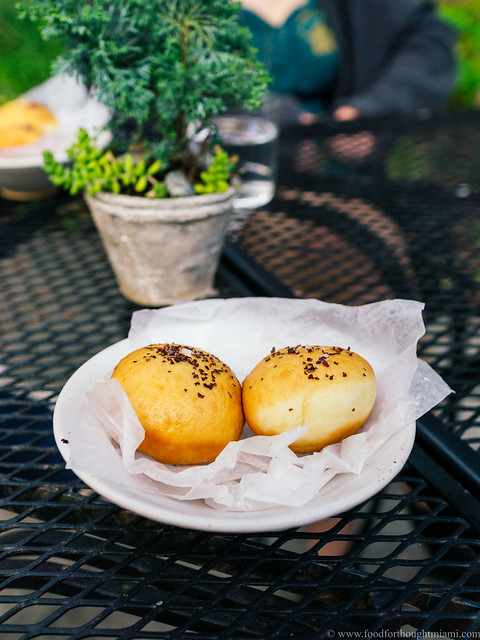 |
| smoked black cod doughnuts - Willows Inn |
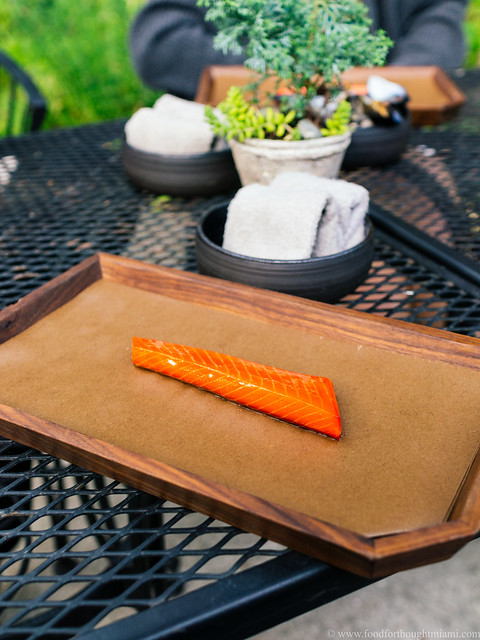 |
| smoked sockeye salmon - Willows Inn |
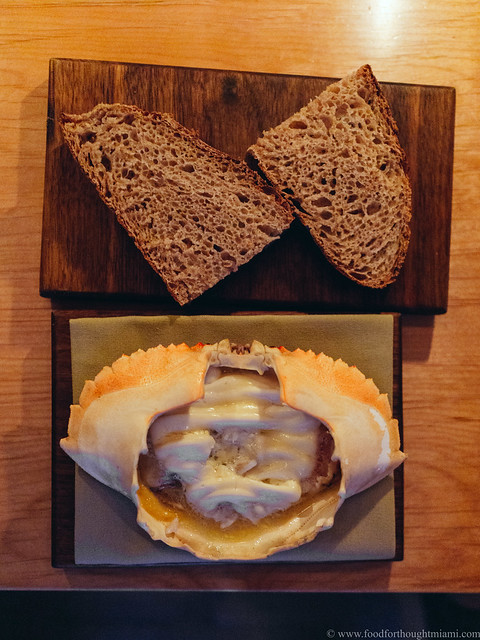 |
| heirloom wheat bread, crab brain - Willows Inn |
 |
| fruits and their leaves and kernels - Willows Inn |
It's unusual for a restaurant to have multiple "signature" dishes, but several from Willows Inn could easily be called that: the "tostada" crafted from a tempura-fried mustard leaf, smeared with an oyster and herb emulsion and festooned with everything fresh and blooming from the garden, a different burst of flavor in every bite; the puffy donuts stuffed with smoked black cod, sprinkled with sea salt and dried seaweed; the perfect smoked salmon, about which I said five years ago: "You realize: this is the best salmon you are ever going to eat in your life." I didn't consider at the time: you can always go back. This time was just maybe even better.
The other dishes pictured here reflect how Wetzel so effectively captures place and time, location and season. During our first two visits, a hearty bread course was one of the highlights, in large part because it came with a ramekin of rich, sticky chicken drippings for dipping. This time, instead of chicken drippings, there was a crab carapace – from nearby waters, of course[1] – filled with bits of warm crabmeat covered in a thick blanket of creamy crab brains, with an intense but clean and pure taste of the sea. Frod Jr. told me months later he was still thinking about how good this was. Yup. Dessert was pretty magical too: an assortment of fruits captured at their peak of ripeness, paired up with something else from the same fruit: peaches and blackberries with ices made from their leaves, plums in a syrup of their kernels, obscenely fresh figs right off the tree with a fig leaf cream.
When I win the lottery – or maybe even if I don't – this is where you'll find me one day.
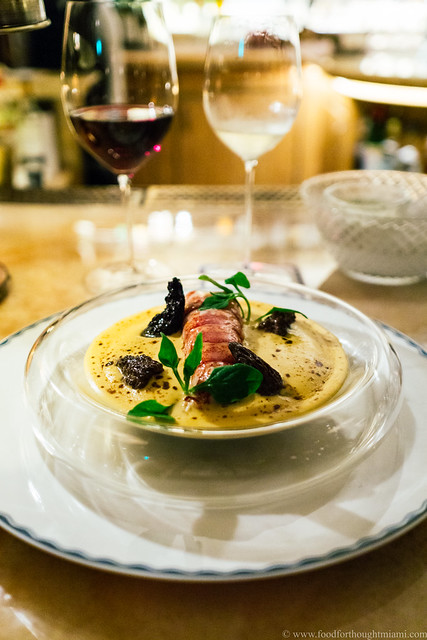 |
| lobster thermidor - The Surf Club Restaurant |
The space is gorgeous, the service is outstanding, the execution is precise, but the choices are just ... so ... dull. I get the whole “throwback” theme, and it provides some highlights (the Oysters Rockefeller are second only to Galatoire’s IMO, and I thought the Lobster Thermidor was great), and I like going there. But when I heard we were getting a Thomas Keller restaurant, and when he brought in a creative, talented chef like Manuel Echeverri, who was doing great things at Bazaar Mar, to run the kitchen – well, I was hoping for something more.
The truth is, I have ambivalent feelings about the Surf Club. I've thoroughly enjoyed my three visits there; just not so much for the food, which has been good, but not particularly memorable. I expected more things like the Lobster Thermidor, an Escoffier classic which frankly I'd never had a particularly good example of until this one. Instead of the typical stodgy spackle mounded into a lobster shell, this version held some surprises: a ragout of lobster meat and vegetables plus a thin sheet of crispy puff pastry concealed under a burnished blanket of cream and cheese, the perfume of tarragon wafting from within, all serving as the bed for a precisely cooked lobster tail, some preserved morels providing a rich, woodsy counterpoint which acted as a bridge for the aromatic red Burg that wine director Zach Gossard generously poured for me. More like this, please.
(continued ...)
 |
| beef tartare, mole cured egg yolk, cactus, cacahuate peanuts - Alter |
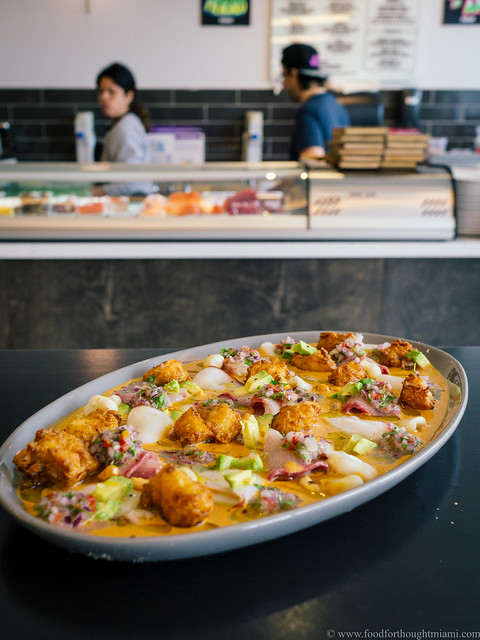 |
| tiradito del mar - Itamae |
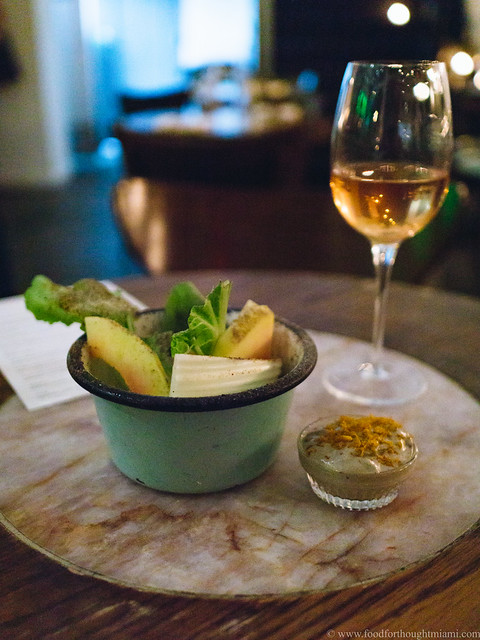 |
| crudites, eggplant, bottarga, green fruits - Jose Ramirez-Ruiz All Day Pop-Up |
 |
| trifle, star fruits, white chocolate, kombu - Jose Ramirez-Ruiz All Day Pop-Up |
In a stroke of good luck for Miamians, Ramirez-Ruiz made his way down here, and has been doing consulting work while contemplating the next step. We got a bit of a preview of what that might be when he did a two-night pop-up in December at All Day, Camila Ramos' wonderful downtown coffee shop. The menu was designed to be like those natural wine bars that have been all the rage in Paris, a place where you can pop in and grab a couple glasses of funky wine and a couple plates of funky food. But given this was just a temporary window of opportunity, I made my way through about two-thirds of the menu in one brief sitting (more pictures in this Jose Ramirez-Ruiz @ All Day flickr set). And it was one of the most interesting and inspired meals I've had in Miami all year, using local products like plantains, betel leaves, and tropical fruit in ways I haven't seen before.
It feels kind of weird to say this, but one of the standouts was – a crudites platter? I didn't expect that, and that's exactly why it stood out. Ramirez-Ruiz took a bowl of fresh local vegetables – crisp, fresh greens, radishes, Hakurei turnips and the like – threw in slices of crunchy green papaya just starting to show a blush of pink, dusted it with some magical spice, and served it with a dark, creamy smoked eggplant dip given a generous dusting of bottarga (shaved dried mullet roe, a wonderfully flavorful product that can be sourced from the Gulf Coast but which rarely is seen on menus). It was a combination unlike any I'd had before but all somehow made sense.
His trifle dessert had the same impact: an unexpected and unorthodox use of local ingredients that still felt natural instead of contrived. Subtly sweet and tart chunks of local star fruit; a sneaky umami bass note from kombu-infused cream;[2] a dusting of white chocolate shavings for creamy sweetness. Very cool.
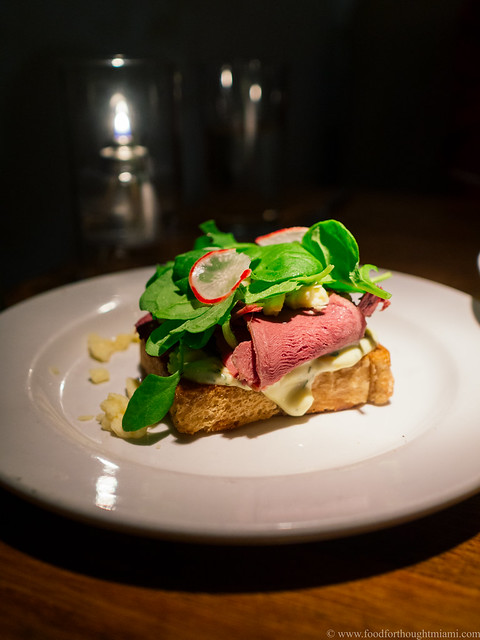 |
| beef tongue tartine - Ariete |
Our most recent meal there in December was the best yet. I loved a salad of local heirloom beans, slivered and dressed in an orange vinaigrette with star fruit, ricotta salata, pumpkin seeds, and some absolutely gorgeous and delicious castelfranco radicchio from Swank. But I loved even more this tartine of tender, rosy smoked beef tongue, served on a Texas toast sized slab of country white bread, generously dressed with sauce gribiche, enriched with some crumbled white cheddar, and then crowned with some perky local greens and radishes.
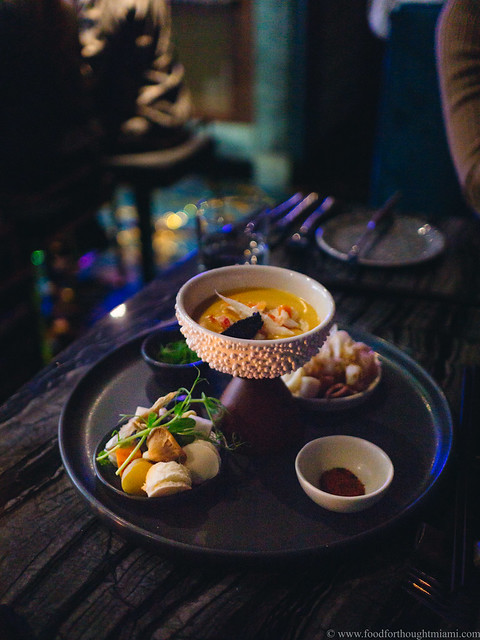 |
| uni fondue - Kaido |
These kind of cocktail-focused places often treat the food as an afterthought, but that isn't going to happen if Brad is running the kitchen. And everything we had was really delicious, including a sashimi of fatty hamachi with citrus ponzu and chile vinegar, grilled enoki mushrooms basted with umami butter,[3] and an outstanding take on tori negi (robata grilled chicken with melted leeks). But there's one particular item on Kaido's menu that's already destined to become a signature dish: Kaido's uni fondue. A molten, creamy sauce infused with sea urchin and aged parmesan cheese arrives at the table in a bowl along with a miscellany of things for dipping: scallops, shrimp and squid, an assortment of vegetables, puffy little buns. There's some togarashi powder and slivered scallions to further adorn your little morsel after it emerges from a dip. You can further gild the lily by adding king crab and/or caviar to the fondue. It was one of Daniel Boulud's three favorite things he ate in 2018.[4] It was one of my favorites too.
Many thanks to the countless people who fed me so well over the past year, and best wishes to all for a happy, healthy and rewarding 2019.
[1] We saw smaller versions of these shells washed up among the pebbles on Sunset Beach, picked clean by the seagulls.
[2] I think that's where the kombu made its way into the trifle, anyway.
[3] That butter is borrowed from the bread and butter service at Alter.
[4] Boulud also included the lobster thermidor at the Surf Club, which is here on this list as well. Me and Boulud, we're just the same, really.
[2] I think that's where the kombu made its way into the trifle, anyway.
[3] That butter is borrowed from the bread and butter service at Alter.
[4] Boulud also included the lobster thermidor at the Surf Club, which is here on this list as well. Me and Boulud, we're just the same, really.

No comments:
Post a Comment